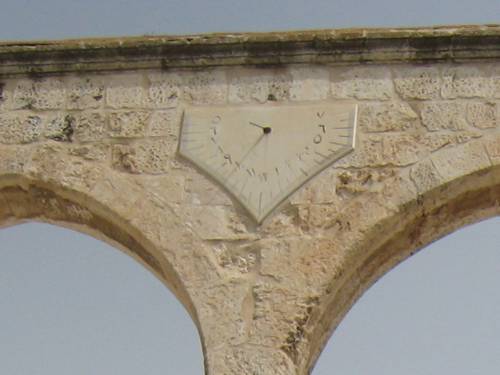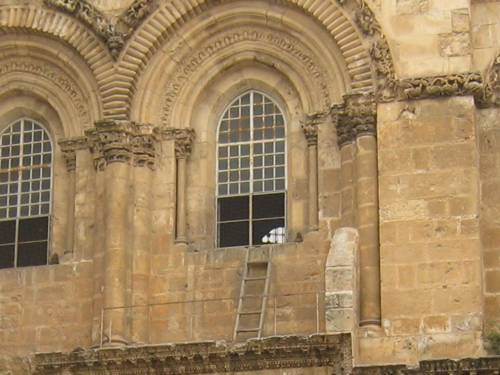 |
 |
 |
20 |
|
ב׳ |
 |
| 21 |
|
ג׳ |
| 22 |
|
ד׳ |
| 23 |
|
ה׳ |
| 24 |
|
ו׳ |
| 25 |
|
ז׳ |
| 26 |
● |
ח׳ |
| 27 |
|
ט׳ |
| 28 |
|
י׳ |
| 29 |
|
י״א |
| 30 |
|
י״ב |
 |
1 |
|
י״ג |
| 2 |
|
י״ד |
| 3 |
|
ט״ו |
| 4 |
|
י״ו |
| 5 |
|
י״ז |
| 6 |
|
י״ח |
| |
|
|
|
|
|
I love the New Imperial Hotel ("New Imperial" according to the signs; "East New Imperial" according to the reservation): It was unique, convenient, and fun. The staff was a mix of every major subpopulation you find in Israel. The decorations were selected, probably without exception, to highlight the peace process – ranging from reproductions of ancient documents to new artworks to items made by various communities to raise money for peace work.
But I can't shake the feeling that it was established by a very short person who decided to open a hotel without ever having seen one before. When they took my reservation, no security was required at all; it is as if they have never encountered a "no show." Our room's key ring holds two keys, but only one of them works in the single keyhole in our room. None of the linens match and none can be bleached. (Billy's towel is medium sized and peach colored while mine is large and purple-green-blue striped.) The "double" room is on two levels, with three beds (2 twin upstairs and a full downstairs). No mirror in the place tops out at higher than my mouth level, and most only go up to my neck level. And the overhang coming down the stairs must be carefully avoided by people of normal height.
Breakfast was an opportunity to enjoy the unfamiliar: It included hummus, semi-sweet doughnut-shaped crackers, warm milk, and a cotton candy-like substance that they called EN halaawi AR حلاوي (although properly in Arabic it's EN halaawa AR حلاوة , and it's easier to find references to it as under the Hebrew name EN halva HE חלבה ). Despite the odd combinations, though, the meal was delicious, and I found myself looking forward to it the next morning. And I was especially glad to learn that there is a place for cotton candy outside the fairground.
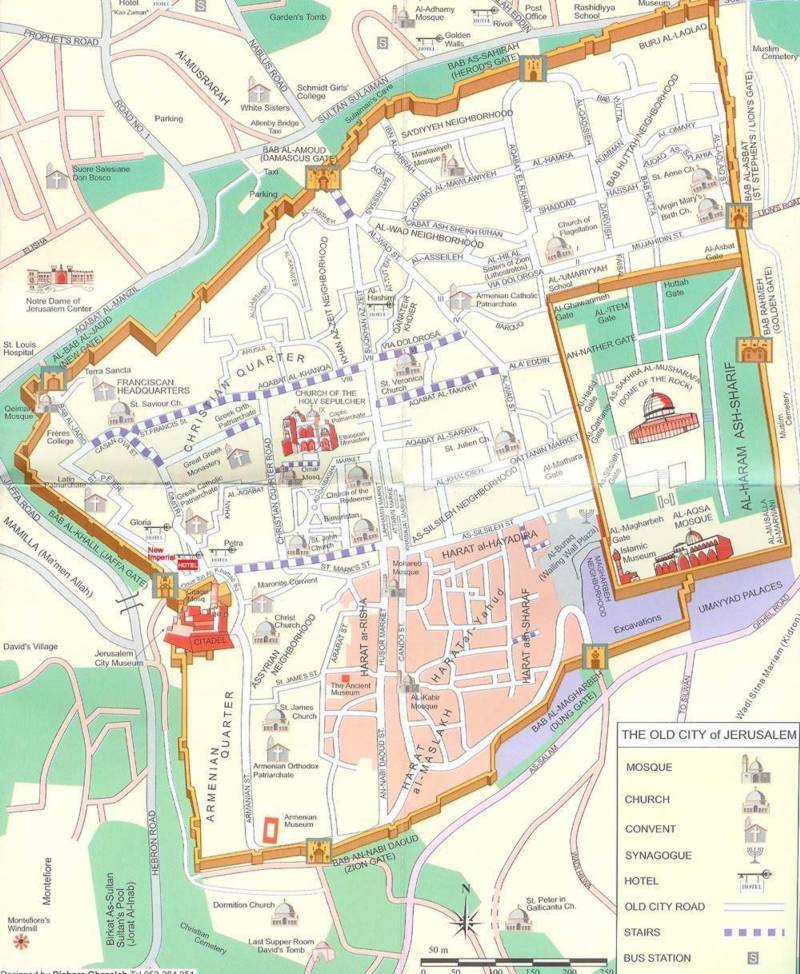 |
Location of Our Hotel (center left) in the Old City |
| ... And I Love Jerusalem! |
| World Heritage Site |
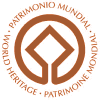 |
 |
Old City of Jerusalem and its Walls
Date of Inscription: 1981 (proposed for inscription by Jordan)
Brief Description: As a holy city for Judaism, Christianity and Islam, Jerusalem has always been of great symbolic importance. Among its 220 historic monuments, the Dome of the Rock stands out: built in the 7th century, it is decorated with beautiful geometric and floral motifs. It is recognized by all three religions as the site of Abraham's sacrifice. The Wailing Wall delimits the quarters of the different religious communities, while the Resurrection rotunda in the Church of the Holy Sepulchre houses Christ's tomb.
Date of Inscription to List of World Heritage in Danger: 1982
Threats to the Site: The situation of Jerusalem is an exceptional one in that there is no general political agreement as to the status of the city, certain states declaring that they abided by the situation defined in the 1947 United Nations partition plan which considered Jerusalem as a corpus separatum located neither in Israel, nor in Jordan.
The site of Jerusalem was nominated in 1981 by Jordan, it being agreed at the time that inscription should in no way be regarded as a means for registering political or sovereignty claims by any State. Its subsequent inscription on the List of World Heritage in Danger in 1982 was a recognition by the Committee of the danger to religious properties, threats of destruction following uncontrolled urban development and of the general deterioration of the state of conservation of the city's monuments due to the disastrous impact of tourism and to lack of maintenance.
The safeguarding of the monumental, religious and cultural heritage of the Holy City of Jerusalem has been one of UNESCO's main concerns since 1967. To this end, the Executive Board and the General Conference have repeatedly requested the application of internationally recognised principles, especially the UNESCO Convention for the Protection of Cultural Property in the Event of Armed Conflict (the Hague, 1954), the 1956 New Delhi Recommendation on International Principles Applicable to Archaeological Excavations and the 1972 World Heritage Convention. In conformity with UNESCO's resolutions, financial aid for heritage restoration projects in Jerusalem has been requested from Member States. Favourable responses to these appeals have enabled UNESCO to finance the restoration and conservation of a number of monuments and religious and cultural properties in this city.
| Criteria: |
|
i. |
|
to represent a masterpiece of human creative genius; |
| |
✔ |
ii. |
|
to exhibit an important interchange of human values, over a span of time or within a cultural area of the world, on developments in architecture or technology, monumental arts, town-planning or landscape design; |
| |
✔ |
iii. |
|
to bear a unique or at least exceptional testimony to a cultural tradition or to a civilization which is living or which has disappeared; |
| |
|
iv. |
|
to be an outstanding example of a type of building, architectural or technological ensemble or landscape which illustrates (a) significant stage(s) in human history; |
| |
|
v. |
|
to be an outstanding example of a traditional human settlement, land-use, or sea-use which is representative of a culture (or cultures), or human interaction with the environment especially when it has become vulnerable under the impact of irreversible change; |
| |
✔ |
vi. |
|
to be directly or tangibly associated with events or living traditions, with ideas, or with beliefs, with artistic and literary works of outstanding universal significance. (The Committee considers that this criterion should preferably be used in conjunction with other criteria); |
| |
|
vii. |
|
to contain superlative natural phenomena or areas of exceptional natural beauty and aesthetic importance; |
| |
|
viii. |
|
to be outstanding examples representing major stages of earth's history, including the record of life, significant on-going geological processes in the development of landforms, or significant geomorphic or physiographic features; |
| |
|
ix. |
|
to be outstanding examples representing significant on-going ecological and biological processes in the evolution and development of terrestrial, fresh water, coastal and marine ecosystems and communities of plants and animals; |
| |
|
x |
|
to contain the most important and significant natural habitats for in-situ conservation of biological diversity, including those containing threatened species of outstanding universal value from the point of view of science or conservation. |
|
|
It was finally time to see EN Jerusalem HE ירושלים AR أورشليم القدس or, simply, القدس . Obviously it's not true for most of Asia, and much of Africa, and a little of the Pacific – but for about half of the world, and all of my world, Jerusalem is the center of the world.
And Jerusalem on its own was spectacular. I approached it with a more carefree spirit than most Americans, and probably more than most of the tourists there. But by that I only mean that I wasn't worried about terrorism. I didn't know what to expect of the people – how they would treat each other, and how they would treat me. The answer I eventually came to was, "very, very well." And I came to be ashamed of the initial distrust of people I had brought with me, unwittingly, to the Middle East. The more time I spent in its streets, the more Jerusalem supplanted my cynicism with innocence. And I came to be confused by the fact that this surprised me.
With minimal editing, this is what I wrote, back at the hotel, on the evening of my first day in Jerusalem. You can see these initial perceptions infused in the "more mature" trip report, which continues below it.
After a day of scouring Jerusalem, we enjoyed a bit of smugness thinking about all the people worried about our welfare on this trip. Jerusalem feels safe and welcoming. Statistically, a visit here is safer than a visit to the U.S., and the mood on the street reflects this. Here are a couple of anecdotes:
- In an unlighted niche in the Church of the Holy Sepulchre, an Arab teenager (I know because I asked AR «ما هذه؟» AR "Ma hatha?" EN "What's that?" ; and he understood and answered in Arabic) was trying to see a floor panel with his lighter, which wouldn't strike. I showed him that we could see it with the backlight from my PDA screen. His natural gesture was to take the phone out of my hand, hold it up to my face to see me in the dark, hold it up to the thing he was trying to see, and then hand it back to me. He didn't ask permission to grab it, but it didn't seem to cross his mind that I would object (which I didn't) or that I would worry about him stealing it (which he didn't).
- A T-shirt vendor and I haggled to a price of 20 ₪, but he was trying hard to get me to settle at 30 ₪ or 35 ₪. When the deal was struck, I handed him a 50 ₪ bill and said, "You're really going to give me 30 back, right?" He said, "Of course" and put a 10 ₪ coin in my hand. I looked momentarily aggrieved before I realized that another employee, whom I hadn't even noticed, was putting a 20 ₪ bill in my hand at that moment. He said, "Did you think I was going to change the price after we agreed on the amount? That would be the same as stealing!"
Jerusalem is incredible: With all of the growth up and over the streets – sometimes completely and at other times for all practical purposes – it almost feels like an underground city.
I really don't know what to write here: I can keep telling you how Jerusalem is nothing like most people expect (or even warn against without having seen it). I can describe shapes and colors: The Haram ash-Shareef is not flat; the buildings and streets are a reddish beige; the city slopes down from the Jaffa Gate to the Western Wall. But I lack the wit and the vocabulary and the insight to truly represent the place – to inform any better than I was informed. It may well be that Jerusalem cannot be described. So all that follows is the thinnest overcoat to the palimpsest of your preconceptions. I wish I could do better, but know that I tried. I'm sorry.
Gertrude Stein once famously said of Oakland, "There is no there there." But in Jerusalem, there's so much "there" there that you can practically wring it from your clothes. The "there" in Jerusalem is like a thick gob of Turkish delight with its powdery sugar covering flaking off to coat your hands and your jeans and your lungs. No sense is left unchallenged in Jerusalem:
- Incense wafts from churches; coffee and shisha smoke from coffeehouses; from elsewhere, spices, diesel exhaust, and fresh cut wood.
- Arabic and pop music bounces up and down the hard stone streets. Five times a day the muezzin issue calls to prayer from loudspeakers atop their minarets. Car horns and ambulances blare. Children run around calling to each other incessantly in what appears as a never-ending game of hide-and-seek or tag in which the walls of the Old City form the boundaries.
- A look in any direction invites chaos to the mind: Most every street-level space is occupied with a shop, the wares spilling out the door and over the threshold and stacked shoulder deep in what is usually a single snaking aisle. The Dome of the Rock is visible across the Old City, an unabating sentinel of what has been lost, or won. People throng constantly with styles of dress to showcase their particular brand of humility – Orthodox clergy in flowing robes, Muslim women with abbayas and hijabs, monks with rope belts, Hareidi with sidelocks and fedoras.
- As for touch, the slick stones underfoot testify to the age of the city. The boxboard kippah at the Western Wall, held in place by hand against the wind, reminds that this is a very sacred place. A careful dance to avoid brushing against strangers becomes second nature – because who can guess what cultural expectations might be offended with an errant touch. People crowd to the edges when slight boys with overladen carts shout AR «يالا» AR "Yalla!" , "Hello!" as they careen down the steps jumping on a tire chained to the cart for slight friction against the smooth walkways.
- The flavor of the air is neither offensive nor desirable, but heavy. Every alley offers unfamiliar foods with unfamiliar spices. Turkish delight and falafel and baklava and diverse fruits abound.
Some people – I used to be one of them – think of New York and Washington and San Francisco as diverse places, but Jerusalem rests on a different plane: Muslims reach al-Aqsa, their third holiest site, on an industrial ramp cantilevered over Judaism's holiest site. The Church of the Holy Sepulchre, where most Christians believe Jesus was crucified, buried, and resurrected, is maintained by Muslims and protected by the Jewish state. Crowds of Christians drag crosses through the Muslim Quarter, wailing and weeping and singing and praying in more tongues than Babel heard, and the shopkeepers don't even look up, as if it happens 20 times a day – because it does. It's not tolerance as we know it, and on a personal level it's not hatred, either; rather, it seems that these groups don't even see each other; only the visitor perceives them all.
My metaphor for Jerusalem is this: A box of doughnuts – each a different flavor, with colorful sprinkles here, sugary filling there, nuts, glaze, caramel, fruit – devoured in a blaring disco after a lick of acid and a hit of speed. Or instead maybe Jerusalem is a stew: with lamb and chicken and cumin and coriander and egg and avocado and potato chips and broken glass and one left shoe.
Or maybe you only need my experience of Jerusalem, rather than my attempt at encapsulating the experience of Jerusalem. I went to the Haram ash-Shareef and looked at al-Aqsa, the Dome of the Rock, and the Dome of the Chain, but as a non-Muslim couldn't go in to the shrines; gorged myself on Turkish delight (AR «حاقوم» AR "halqoom" here); ate a pleasant mixed grill lunch on the roof of Papa Andrea's looking at the forbidden dome; browsed endlessly and bought two T-shirts; visited all four quarters of the Old City, but couldn't distinguish between them because they all seemed Muslim; was glad I chose to learn Arabic instead of Hebrew because everybody speaks it here; was waved through the buzzing and beeping metal detectors at the Western Wall without emptying my pockets or removing my backpack; had a great dinner of khaghoghi derev (minced meat in grape leaves) at the Armenian Tavern; spent hours writing this report while doing laundry and listening (whether I wanted to or not – but I did) to a bar on the street below our window ("My Way" in Arabic has come through the rotation twice).
To my experience, Jerusalem seethes with the welcoming unfamiliar. It's the most exotic place I've ever seen. It's one of the few places I've traveled that I wouldn't want to live – but it is a place I cherish and to which I would eagerly return.
The name of the city is – ironically – likely derived from the phrase "heritage of peace" or "heritage of harmony" (the former if the last half of the word derives from EN shalom HE שלום ; the latter if it derives from EN salem HE סאלם ). But there is no shortage of referents to this tiny plot of land:
- EN The Holy AR القدس , sometimes expanded to EN The Noble and Holy AR القدس الشريف , is how the city is ordinarily referenced in Arabic;
- EN Salem HE סאלם ;
- EN Moriah HE מוריה , the name of the mountain;
- EN Jebus HE יבוס (trodden down);
- EN Zion HE ציון ;
- EN Ariel HE אריאל (Lion of God);
- EN City of David HE עיר דוד ;
- EN Oasis of Justice HE נווה צדק (Jeremiah 31:22);
- EN City of the Great King HE קרית מלך רב (Psalms 48:2);
- EN House of Holiness AR بيت المقدس ;
- EN The Farthest Mosque AR المسجد الاقصى ;
- EN al-Balat AR البلاط , from EN palace LA palatium ;
- EN The Lord Sees LA Dominus videt ;
- EN Capitoline Hill of Aelius LA Aelia Capitolina .
Anyway, that's all that I could find in my first hour of searching. And would our lives really be enriched if I had been able to find the full reputed list of "over 70 names." Well, mine would have been – but in deference to my audience, I'll stop here, and move on to another passion: maps. When I say that Jerusalem is the center of the world, I'm speaking from a socio-political viewpoint (as behooves that forgettable degree I've got). But before the halcyon days of Google Earth and GPS, mapmaking was an inexact science, and some early cartographers didn't even try for natural boundaries, instead simply giving an overview of the general relationships between places. Actual navigation involved constantly stopping, asking directions, and availing oneself of the hospitality of others (and, as you'll soon see, it still does if you're traveling with me and Billy). In this light, some early world maps are quite illustrative regarding the importance of Jerusalem.
| Jerusalem |
| Jerusalem here is literally the center of the known world, resting at a point where Europe, Asia, and Africa meet. |
Here Asia is in the shape of Pegasus, the winged horse, with Jerusalem as its heart. |
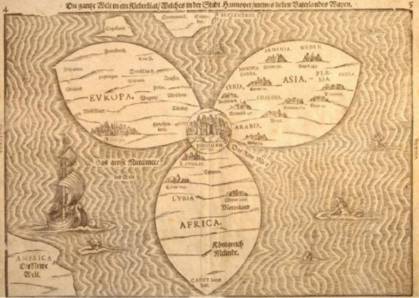 |
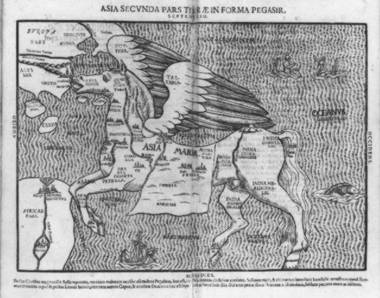 |
And how come? As you have undoubtedly already heard, Jerusalem is viewed with significance by three major world religions.
And in their scriptures, you can find not only a celebration of Jerusalem, but also a palpable distrust of others who dare to call Jerusalem home:
Judaism |
|
| א עַל נַהֲרוֹת, בָּבֶל– שָׁם יָשַׁבְנוּ, גַּם-בָּכִינוּ: בְּזָכְרֵנוּ, אֶת-צִיּוֹן. |
|
1 By the rivers of Babylon, there we sat down, yea, we wept, when we remembered Zion. |
| ב עַל-עֲרָבִים בְּתוֹכָהּ– תָּלִינוּ, כִּנֹּרוֹתֵינוּ. |
|
2 Upon the willows in the midst thereof we hanged up our harps. |
| ג כִּי שָׁם שְׁאֵלוּנוּ שׁוֹבֵינוּ, דִּבְרֵי-שִׁיר– וְתוֹלָלֵינוּ שִׂמְחָה:
שִׁירוּ לָנוּ, מִשִּׁיר צִיּוֹן. |
|
3 For there they that led us captive asked of us words of song, and our tormentors asked of us mirth: 'Sing us one of the songs of Zion.' |
| ד אֵיךְ– נָשִׁיר אֶת-שִׁיר-יְהוָה: עַל, אַדְמַת נֵכָר. |
|
4 How shall we sing the LORD'S song in a foreign land? |
| ה אִם-אֶשְׁכָּחֵךְ יְרוּשָׁלִָם– תִּשְׁכַּח יְמִינִי. |
|
5 If I forget thee, O Jerusalem, let my right hand forget her cunning. |
| ו תִּדְבַּק-לְשׁוֹנִי, לְחִכִּי– אִם-לֹא אֶזְכְּרֵכִי:
אִם-לֹא אַעֲלֶה, אֶת-יְרוּשָׁלִַם– עַל, רֹאשׁ שִׂמְחָתִי. |
|
6 Let my tongue cleave to the roof of my mouth, if I remember thee not; if I set not Jerusalem above my chiefest joy. |
| ז זְכֹר יְהוָה, לִבְנֵי אֱדוֹם– אֵת, יוֹם יְרוּשָׁלִָם:
הָאֹמְרִים, עָרוּ עָרוּ– עַד, הַיְסוֹד בָּהּ. |
|
7 Remember, O LORD, against the children of Edom the day of Jerusalem; who said: 'Rase it, rase it, even to the foundation thereof.' |
| ח בַּת-בָּבֶל, הַשְּׁדוּדָה:
אַשְׁרֵי שֶׁיְשַׁלֶּם-לָךְ– אֶת-גְּמוּלֵךְ, שֶׁגָּמַלְתְּ לָנוּ. |
|
8 O daughter of Babylon, that art to be destroyed; happy shall he be, that repayeth thee as thou hast served us. |
| ט אַשְׁרֵי, שֶׁיֹּאחֵז וְנִפֵּץ אֶת-עֹלָלַיִךְ– אֶל-הַסָּלַע. |
|
9 Happy shall he be, that taketh and dasheth thy little ones against the rock. |
– Psalms 137
Also of note: |
- Jerusalem appears 669 times in the EN Tanakh HE תנ״ך , the set of Jewish scriptures.
- The Passover Seder and Yom Kippur service both conclude with the promise, "Next Year in Jerusalem."
- Jerusalem is prominently mentioned in the Jewish daily prayers.
- Various Jewish customs are meant to remind one of the destruction of Jerusalem: touching ash to the forehead of a groom; smashing the glass in the wedding ceremony; leaving an unpainted interior wall opposite the front door to a home.
|
|
|
|
|
Islam |
|
| سُبْحَانَ الَّذِي أَسْرَى بِعَبْدِهِ لَيْلاً مِّنَ الْمَسْجِدِ الْحَرَامِ إِلَى الْمَسْجِدِ الأَقْصَى الَّذِي بَارَكْنَا حَوْلَهُ لِنُرِيَهُ مِنْ آيَاتِنَا إِنَّهُ هُوَ السَّمِيعُ البَصِيرُ |
|
1 Limitless in His glory is He who transported His servant by night from the Inviolable House of Worship [at Makkah] to the Remote House of Worship [,at Jerusalem] - the environs of which We had blessed -so that We might show him some of Our symbols: for, verily, He alone is all-hearing, all-seeing. |
| وَآتَيْنَا مُوسَى الْكِتَابَ وَجَعَلْنَاهُ هُدًى لِّبَنِي إِسْرَائِيلَ أَلاَّ تَتَّخِذُواْ مِن دُونِي وَكِيلاً |
|
2 And [thus, too,] We vouchsafed revelation unto Moses, and made it a [source of] guidance for the children of Israel, [commanding them:] "Do not ascribe to any but Me the power to determine your fate, |
| ذُرِّيَّةَ مَنْ حَمَلْنَا مَعَ نُوحٍ إِنَّهُ كَانَ عَبْدًا شَكُورًا |
|
3 O you descendants of those whom We caused to be borne (in the ark] with Noah! Behold, he was a most grateful servant (of Ours]!" |
| وَقَضَيْنَا إِلَى بَنِي إِسْرَائِيلَ فِي الْكِتَابِ لَتُفْسِدُنَّ فِي الأَرْضِ مَرَّتَيْنِ وَلَتَعْلُنَّ عُلُوًّا كَبِيرًا |
|
4 And we made [this] known to the children of Israel through revelation: Twice, indeed, will you spread corruption on earth and will indeed become grossly overbearing! |
| فَإِذَا جَاء وَعْدُ أُولاهُمَا بَعَثْنَا عَلَيْكُمْ عِبَادًا لَّنَا أُوْلِي بَأْسٍ شَدِيدٍ فَجَاسُواْ خِلاَلَ الدِّيَارِ وَكَانَ وَعْدًا مَّفْعُولاً |
|
5 Hence, when the prediction of the first of those two [periods of iniquity] came true, We sent against you some of Our bondmen of terrible prowess in war, and they wrought havoc throughout the land: and so the prediction was fulfilled. |
| ثُمَّ رَدَدْنَا لَكُمُ الْكَرَّةَ عَلَيْهِمْ وَأَمْدَدْنَاكُم بِأَمْوَالٍ وَبَنِينَ وَجَعَلْنَاكُمْ أَكْثَرَ نَفِيرًا |
|
6 And after a time We allowed you to prevail against them once again, and aided you with wealth and offspring, and made you more numerous [than ever]. |
| إِنْ أَحْسَنتُمْ أَحْسَنتُمْ لِأَنفُسِكُمْ وَإِنْ أَسَأْتُمْ فَلَهَا فَإِذَا جَاء وَعْدُ الآخِرَةِ لِيَسُوؤُواْ وُجُوهَكُمْ وَلِيَدْخُلُواْ الْمَسْجِدَ كَمَا دَخَلُوهُ أَوَّلَ مَرَّةٍ وَلِيُتَبِّرُواْ مَا عَلَوْاْ تَتْبِيرًا |
|
7 [And We said:] "If you persevere in doing good, you will but be doing good to yourselves; and if you do evil, it will be [done] to yourselves." And so, when the prediction of the second [period of your iniquity] came true, [We raised new enemies against you, and allowed them] to disgrace you utterly, and to enter the Temple as [their forerunners] had entered it once before, and to destroy with utter destruction all that they had conquered. |
| عَسَى رَبُّكُمْ أَن يَرْحَمَكُمْ وَإِنْ عُدتُّمْ عُدْنَا وَجَعَلْنَا جَهَنَّمَ لِلْكَافِرِينَ حَصِيرًا |
|
8 Your Sustainer may well show mercy unto you; but if you revert [to sinning], We shall revert [to chastising you]. And [remember this:] We have ordained that [in the hereafter] hell shall close upon all who deny the truth. |
| إِنَّ هَـذَا الْقُرْآنَ يِهْدِي لِلَّتِي هِيَ أَقْوَمُ وَيُبَشِّرُ الْمُؤْمِنِينَ الَّذِينَ يَعْمَلُونَ الصَّالِحَاتِ أَنَّ لَهُمْ أَجْرًا كَبِيرًا |
|
9 Verily, this Qur'an shows the way to all that is most upright, and gives the believers who do good deeds the glad tiding that theirs will be a great reward; |
| وأَنَّ الَّذِينَ لاَ يُؤْمِنُونَ بِالآخِرَةِ أَعْتَدْنَا لَهُمْ عَذَابًا أَلِيمًا |
|
10 and [it announces, too,] that We have readied grievous suffering for those who will not believe in the life to come. |
– Qur'an 17:1-10
Also of note: |
- Jerusalem is important in the lives of many of the prophets of Islam, including David, Solomon, Jesus, and Muhammad.
- For the first seventeen months of Islam, Jerusalem was the direction of prayer, or EN qibla AR قبلة , before God instructed Muhammad (suddenly one day, in the middle of noon prayers) to turn and face EN the Kaaba AR الكعبة instead.
- Jerusalem is identified in some hadith as the place where all humanity will be gathered for judgment.
- The conquest of Jerusalem is taken as one of the signs of the "approach of the hour" (end of time).
- Some hadith (recognized only by Sunnis) identify Jerusalem as the site of the second mosque, and one of only three cities to which pilgrimages are made.
- The earliest inscriptions of the Qur'an are in the Dome of the Rock.
- When Jerusalem was taken by the second caliph, EN Umar ibn al-Khattab AR عمر بن الخطاب , he found the Temple Mount being used as a garbage dump by the inhabitants of Jerusalem, and began to restore it to holy use.
|
|
|
|
|
Christianity |
|
| 31 At that time some Pharisees came to Jesus and said to him, "Leave this place and go somewhere else. Herod wants to kill you." |
32 He replied, "Go tell that fox, 'I will drive out demons and heal people today and tomorrow, and on the third day I will reach my goal.' |
| 33 In any case, I must keep going today and tomorrow and the next day—for surely no prophet can die outside Jerusalem! |
34 "O Jerusalem, Jerusalem, you who kill the prophets and stone those sent to you, how often I have longed to gather your children together, as a hen gathers her chicks under her wings, but you were not willing! |
| 35 Look, your house is left to you desolate. I tell you, you will not see me again until you say, 'Blessed is he who comes in the name of the Lord.'" |
– Luke 13:31-35
Also of note: |
- The life of Jesus was centered around Jerusalem.
- His crucifixion, burial, and resurrection occurred in Jerusalem.
- Christian churches traditionally face Jerusalem.
|
|
But there have been notable moments of coexistence and cooperation, even at the most trying of times:
- It was in Jerusalem that the second caliph, Umar ibn al-Khattab, wrote the Pact of Umar, which codified the rights of "People of the Book" (Jews and Christians) living in Muslim lands.
- Some say that Umar's restoration of the Temple Mount was not a mosque, but rather a rebuilding of the Second Temple in concert with Jerusalem's Jewish population.
- To keep peace among the Christian communities vying for control of the Church of the Holy Sepulchre, the site has been protected since 1192 CE by two Muslim families, one holding the key, and the other keeping the door.
- When Israel gained control of Jerusalem in the 1967 war, there were calls by its citizens to destroy the Muslim holy sites on what the Jews call the "Temple Mount"; the government did not do so, and instead turned over the area's management to a Muslim council.
And not all of the acrimony is between different groups:
- Rabbis are in disagreement over whether it is even permissible to Jews to set foot on the Temple Mount, owing to the holiness of the site, with various propositions: (1) that it will never be permitted until the Messiah returns, (2) that it is permitted, (3) that it is encouraged, (4) that one may ascend only after being immersed in a mikvah, or (5) that one may ascend, but that a mikvah is required after menstruation or receiving seminal fluids (women) or emitting seminal fluids (men).
- Custody of the Church of the Holy Sepulchre is divided (not evenly) among the Greek Orthodox, Armenian Apostolic, Roman Catholic, Coptic Orthodox, Ethiopian Orthodox, and Syriac Orthodox churches. An arrangement, called the "status quo" lists their areas of governance, and states that common areas cannot be changed without agreement from all. This means that some repairs are neglected until the building is a hazard. It has also resulted in fistfights, as recently as 2004 (when a door was left open) and 2002 (when a Coptic monk moved his chair into the shade from its assigned location). (Remember the status quo when we get down to the pictures of the church.)
|
If only all of those groups could unite around a common enemy – such as the Mandaeans: The Mandaeans are a tiny sect that considers John the Baptist extraordinarily noble, and which holds in esteem other figures of the Abrahamic faiths, including Adam and Noah (and some of their immediate descendents) – but which views Jesus as a charlatan, and Abraham, Moses, and Muhammad as false prophets.
And the Mandaeans despise Jerusalem! One of their holy books, the Ginza Rba, makes a few brash claims:
- Jerusalem must flourish for a thousand years, remain a thousand years destroyed, and then the entire material world will be destroyed.
Ginza Rba 18
(ed. note: So far it has been flourishing for 4,600 years.)
- Whoever lives in the city of Jerusalem will not mention the name of God.
Ginza Rba 15:11
(ed. note: Actually they won't shut up about it.)
- Jerusalem came into being as a result of the incestuous union of the seven planets with their evil mother Ruha d-Qudsha, who "left lewdness, perversion, and fornication in it."
Ginza Rba 15:11
(ed. note: Cool!)
But the three major Abrahamic faiths literally swoon over Jerusalem. For Christians, this tends to mean the city as a whole. But for Jews and Muslims, it's really just that (let's be frank) garish plaza at the east end of the Old City. A lot of history has gone into shaping this cultural attachment, but the foundation of it is their shared veneration of the summit of Mount Moriah, now buried under the plaza. Jews hold that the entire world was formed from it, and thus name it the EN Foundation Stone HE אבן השתייה . The EN Midrash Tanhuma HE מדרש תנחומא has this to say about the stone:
As the navel is set in the centre of the human body,
so is the land of Israel the navel of the world...
situated in the centre of the world,
and Jerusalem in the centre of the land of Israel,
and the sanctuary in the centre of Jerusalem,
and the holy place in the centre of the sanctuary,
and the ark in the centre of the holy place,
and the Foundation Stone before the holy place,
because from it the world was founded. |
In Jewish tradition, this is the rock on which the EN Ark of the Covenant HE ארון הברית was placed in the First Temple, on which Abraham prepared to sacrifice Isaac (Muslims say Ishmael – elsewhere), where Jacob dreamt that the ladder to heaven was seated, where King David made his sacrifice, and finally where Solomon built the Second Temple.
Muslims believe that it is where Muhammed ascended to heaven, where all the prophets of Islam have prayed, and where Israfil will blow the last trumpet on Resurrection Day.
Christians, by and large, give it a pass. (The Mandaeans would probably pack it with dynamite.)
And (while acknowledging through official channels the importance of the site to other groups) they've been slathering denials of opposing claims like paint on a barn since the days of the second caliph: Muslims refute the historical ties claimed by Judaisim, offering that their building on the plaza was possible only because it was being used as a garbage dump when Umar took Jerusalem. Jews refute the historical ties claimed by Islam, pointing to the fact that Jerusalem is never mentioned by name in the Qur'an (and thereby implying that "the farthest mosque" could be anywhere). And scholars take up where the faithful leave off: It has been noted that measurements in the Talmud make it impossible for the location of the Second Temple to have been located on the same site as the Dome of the Rock (although still, it must be acknowledged, on the Temple Mount). The Muslim name for the Western Wall, EN al-Buraq Wall AR حائط البراق , comes from a claim that Muhammad's horse of that name was tethered to that wall, but research finds that claim only in documents prepared in the last hundred years. The belief that the summit of Mount Moriah is the place where Abraham prepared to sacrifice Isaac is important to Jewish veneration of the site – but scriptural references indicated that (1) Abraham did this at a site in the wilderness and (2) Jerusalem was a city big enough to have its own priest in the time of Abraham.
Anyway, I have just scratched the surface to give you an idea of the import of the place in the eyes of its peoples. For every claim, there are refutations, counter claims, denials, and rebukes. And all that I have to offer is a precious little knowledge – and a defense of that meager learning in the immortal words of Terry Pratchett: "They say that a little knowledge is a dangerous thing, but it is not one half so bad as a lot of ignorance."
But it shouldn't come as a surprise that Jerusalem raises the emotion-meter into the red zone, as ours is indeed a world fraught with feeling about this city – and it's not just this stuff above, not just stuff you've heard about, not just stuff that makes sense. Even the innocuous phrase, "hip, hip, hooray," has a likely etymology in an anti-Semitic call for Jerusalem's destruction: Like most short words without a clear linguistic heritage, "hip," found reinforcement in multiple different usages in divers communities. One of these was German anti-Semites, who mustered themselves with the call "Hep! Hep!" so enthusiastically that their 1819 disturbances were known as the "Hep-Hep Riots." It was claimed that they used "Hep!" in remembrance of a Crusader rally, in which this word was an acronym for "LA Hierosolyma est perdita EN Jerusalem is Lost ."
So I had done the learning; now I was ready to start the experiencing: I started the day early, walking straight to the EN The Jewish Quarter HE הרובע היהודי , past the Western Wall, and then up to the plaza it faces – which the Jews call the EN Temple Mount HE הר הבית and the Muslims refer to otherwise (keep reading). This was a major goal of the trip for me, and an amazing experience. As a non-Muslim, I was not permitted inside the 1300-year-old Dome of the Rock or al-Aqsa Mosque, but I had free access to the outdoor areas of the plaza.
The EN Dome of the Rock AR مسجد قبة الصخرة was particularly beautiful and particularly meaningful, and I hated missing my opportunity to see the stone itself. But those are (currently) the rules; they've changed several times in my lifetime, however – so I hope I may someday find myself in Jerusalem when the circumstances are more accommodating.
The Muslim term for this "Temple Mount" area is a bit of a moving target. Historically, it was called EN al-Aqsa Mosque AR المسجد الاقصى , and Islamic law still assigns this meaning to this term – but in ordinary modern parlance, "al-Aqsa Mosque" is understood as the house of worship on southern end of the plaza. Most typically in Arabic, the general area is known as EN The Noble Sanctuary AR الحرم الشريف AR al-haram ash-sharif ; sometimes in Arabic the word for "holy" is inserted in the middle: AR الحرم القدسي الشريف AR al-haram al-qudsi ash-sharif . But for reasons I cannot discern, the English translation does not change as expected to "The Holy and Noble Sanctuary." Because it was the original direction of prayer, the area is sometimes known as the "First of the Two Qiblas."
The building generally known as EN al-Aqsa Mosque AR المسجد الاقصى is more precisely – but less commonly – known as EN the Mosque of al-Aqsa Mosque AR جامع المسجد الاقصى (in Arabic two different words for "mosque" are used – AR جامع and AR مسجد – so it doesn't sound as weird in the vernacular) or EN the Mosque of the Qibla AR المسجد القبلي . It is a much less stunning building than the Dome of the Rock, but is graceful and beautiful in its own right. Heavily damaged by earthquakes in the early 20th century, much of what you see today is relatively new construction. But the framework of the building is nearly as old as the Dome of the Rock. It was constructed by the second caliph in the early days of Islam, when the qibla (direction of prayer) had recently been shifted from Jerusalem to EN Makkah al-Mukarramah AR مكة المكرمة . He positioned it deliberately so that the rock did not fall between the mosque and Makkah, to reinforce Makkah's primacy. (I write "Makkah" instead of "Mecca" in deference to the Saudi government's transliteration, which intends to distinguish between the metaphorical use "mecca" and the holy city "Makkah.")
I left the Haram ash-Sharif before mid-day prayers, as I didn't want the stress of being chased away, and returned to the hotel to meet up with Billy.
 Billy and I first went for lunch at Papa Andrea's, a place recommended in the Lonely Planet: Middle East book. It was recommended for its excellent food and rooftop views. I had Jerusalem mixed grill, a dish I had dreamed about since I learned of it months before the trip began. I had thought it somewhat like haggis (which I fondly remembered from Scotland) because of the use of offal, but it wasn't quite. Still, it was good. Billy and I first went for lunch at Papa Andrea's, a place recommended in the Lonely Planet: Middle East book. It was recommended for its excellent food and rooftop views. I had Jerusalem mixed grill, a dish I had dreamed about since I learned of it months before the trip began. I had thought it somewhat like haggis (which I fondly remembered from Scotland) because of the use of offal, but it wasn't quite. Still, it was good.
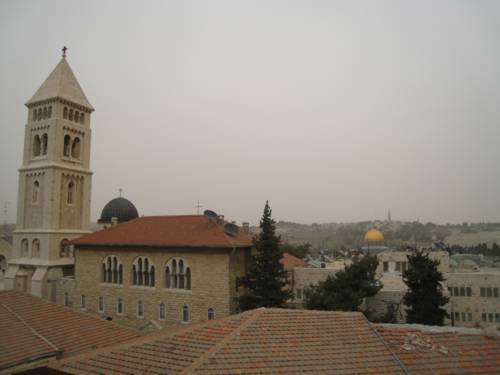 |
View from the Roof of Papa Andrea's Restaurant |
Then we made our way to the nearby Church of the Holy Sepulchre, where Catholic and Orthodox doctrines (but not Protestant) hold that Jesus was crucified and buried. Remember the "status quo" document I mentioned earlier governing the structure of this building? See that ladder under the top-right window in the first picture? It's there now because it just happened to be there when the status quo was written. Not only can it never be removed, but it actually must be replaced every time it rots. As far back as you can find pictures of the Church of the Holy Sepulchre, you will find a ladder in this position.
Having been to the spot that Jews consider the center of the earth (or, actually, near it – but closer than many of them can get), I would have liked to have known – while I was there – that the Greek Orthodox faith considers the center of the world to be on the floor of the Catholicon (the Greek Orthodox cathedral within the Church of the Holy Sepulchre). They have marked the precise spot with a marble EN omphalos EL όμφαλoς – a sort of vase-like thing. The word means "navel" in Greek, and this is how Greeks of various traditions mark the respective loci of their centers of the world; omphali have also been placed, for example, (by people in different traditions) at EN Pythia EL Πυθία and EN Delphi EL Δελφοί . Unfortunately, I didn't know any of this until my post-trip research, so I missed my chance to snap a shot of the only center-of-the-world in Jerusalem that I had access to. Damn! (Now you're probably saying, "Why is he writing 'omphali' as the plural of 'omphalos'? Doesn't he realize that the '-us' to '-i' transformation only affects second-declension Latin nouns which end in '-us,' and that 'omphalos' [1] doesn't end in '-us,' [2] isn't second-declension Latin, and [3] for that matter isn't Latin at all? Is he the kind of moron who would write 'peni' instead of 'penes,' 'rhinoceri' instead of 'rhinocerotes,' 'octopi' instead of 'octopodes,' 'opi' instead of 'opera,' 'viri' instead of 'viruses'? Kill him," you must be saying, "if he has no more respect for language than that!" But hark mad mob! Put down your torches and pitchforks. I looked it up: "omphali" really is the plural of "omphalos." See for yourself.)
Then we went a few blocks over to the EN Western Wall HE הכותל המערבי , to stand as close as most Jews get to their center of the world.
Okay, lest I be accused of trivializing and over-generalizing:
- Remember that many authorities, including the Chief Rabbinate of Israel, hold that Jews may not go on the Temple Mount because of the holiness of the site (see above). And even if they do, the Muslim council that governs that area forbids any but Muslim prayers there. So if they want to pray, this is as close as they can easily get.
- While it is true that Jews hold the Foundation Stone to be the center of the world, their reverence for the Western Wall is not because of the stone, but because of the Second Temple that once stood (not coincidentally) above it.
- There is a portion of the Western Wall closer to the sacred location of the Second Temple, but it lies underneath the Muslim Quarter in the Western Wall Tunnels. So while it is even more sacred, and while people do indeed go there to pray, it is not easily accessible like this exposed portion of the Western Wall. (You'll see this in tomorrow's trip report, which details our visit to the tunnels.)
Then we ambled around the Muslim Quarter (which was known as the Mixed Quarter because of its diversity prior to the riots of 1929; Jews and Christians still have a presence there) and the Via Dolorosa.
|
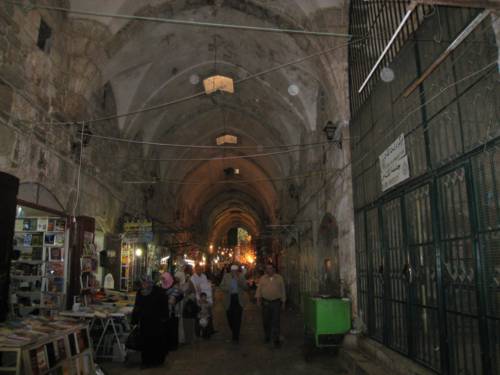 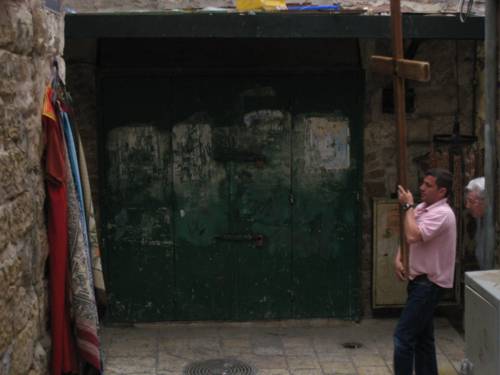
|
quar·ter /ˈkwɔrtər/
–noun
| 1. |
|
one of the four equal or equivalent parts into which anything is or may be divided: a quarter of an apple; a quarter of a book. |
| 2. |
|
a fourth part, esp. of one (1/4 ). |
| 3. |
|
one fourth of a U.S. or Canadian dollar, equivalent to 25 cents. |
| 4. |
|
a coin of this value. |
| 5. |
|
one fourth of an hour: He stayed there for an hour and a quarter. |
| 6. |
|
the moment marking this period: The clock struck the quarter. |
| 7. |
|
one fourth of a calendar or fiscal year: The bank sends out a statement each quarter. |
| 8. |
|
Astronomy. |
| |
|
| a. |
|
a fourth of the moon's period or monthly revolution, being that portion of its period or orbital course between a quadrature and a syzygy. |
| b. |
|
either quadrature of the moon. Compare first quarter, last quarter. |
|
| 9. |
|
(in schools, colleges, and universities) one of the terms or periods into which instruction is organized, generally 10 to 12 weeks in length. |
| 10. |
|
Sports. any of the four periods that make up certain games, as football and basketball. Compare half. |
| 11. |
|
one fourth of a pound. |
| 12. |
|
one fourth of a mile; two furlongs. |
| 13. |
|
one fourth of a yard; 9 inches. |
| 14. |
|
a unit of weight: one fourth of a hundredweight. In the U.S. this equals 25 lbs. and in Britain 28 lbs. |
| 15. |
|
British. a measure of capacity for grain, etc., equal to 8 bushels, or, locally, to approximately this. |
| 16. |
|
the region of any of the four principal points of the compass or divisions of the horizon. |
| 17. |
|
such a point or division. |
| 18. |
|
any point or direction of the compass: The wind is blowing in that quarter. |
| 19. |
|
a region, district, or place. |
| 20. |
|
a particular district of a city or town, esp. one generally occupied by a particular group of people: the Turkish quarter; an artists' quarter. |
| 21. |
|
Usually, quarters. |
| |
|
| a. |
|
housing accommodations, as a place of residence; lodgings. |
| b. |
|
Military. the buildings, houses, barracks, or rooms occupied by military personnel or their families. |
|
| 22. |
|
Often, quarters. an unspecified part or member of a community, government, etc., that serves as a source of information or authority: He received secret information from a high quarter. |
| 23. |
|
mercy or indulgence, esp. as shown in sparing the life and accepting the surrender of a vanquished enemy: to give quarter; to ask for quarter. |
| 24. |
|
one of the four parts, each including a leg, of the body or carcass of a quadruped. |
| 25. |
|
Veterinary Medicine. the part of a horse's hoof between heel and toe. |
| 26. |
|
Shoemaking. the part of a boot or shoe on each side of the foot, from the middle of the back to the vamp. |
| 27. |
|
Nautical. |
| |
|
| a. |
|
the after part of a ship's side, usually from about the aftermost mast to the stern. |
| b. |
|
the general horizontal direction 45° from the stern of a ship on either side: Another boat is coming near on the port quarter. |
| c. |
|
one of the stations to which crew members are called for battle, emergencies, or drills. |
| d. |
|
the part of a yard between the slings and the yardarm. |
| e. |
|
quarter point. |
|
| 28. |
|
Heraldry. |
| |
|
| a. |
|
any of the four equal areas into which an escutcheon may be divided by a vertical and a horizontal line passing through the center. |
| b. |
|
any of the variously numbered areas into which an escutcheon may be divided for the marshaling of different arms. |
| c. |
|
any of the arms marshaled on an escutcheon. |
| d. |
|
a charge occupying one quarter of an escutcheon, esp. that in dexter chief. Compare canton. |
|
| 29. |
|
each half of a cask, consisting of the portion from the bilge to the top chime and the portion from the bilge to the bottom chime. |
|
|
And finally we had a fantastic meal of khaghoghi derev (minced meat in grape leaves) at the Armenian Tavern in the Armenian Quarter (another Lonely Planet: Middle East recommendation).
And with that we had covered all four of Jerusalem's quarters:
- The Christian Quarter (our hotel; Papa Andrea's, the Church of the Holy Sepulchre);
- The Jewish Quarter (the Western Wall);
- The Muslim Quarter (the Via Dolorosa); and
- The Armenian Quarter (the Armenian Tavern).
One is tempted to think that "quarter" in this context refers to definitions 1 and 2 above, because there are four quarters, and they are roughly equivalent sizes (if you ignore the Temple Mount/Noble Sanctuary). But the correct definition is actually definition 20, as simple arithmetic informs us: In 1967 there were five quarters, the extra one being the EN Mughrabi Quarter AR حارة المغاربة (sometimes translated as the "Moroccan Quarter") – which was leveled by the Israelis in retaliation for the near destruction of the Jewish Quarter. The Jewish Quarter was rebuilt (in a style that makes it difficult to distinguish the new from the old), but the Mughrabi Quarter remains quite literally flattened, and is now known as the Western Wall Plaza.
After dinner we enjoyed the spectacular night lighting of the EN Tower of David HE מגדל דוד , a citadel built to guard this relatively weak area of Jerusalem's defenses. And then we made our way past the EN Jaffa Gate HE שער יפו AR باب الخليل to our nearby hotel for laundry, writing of this first draft, and sleep.
|



 Billy and I first went for lunch at Papa Andrea's, a place recommended in the Lonely Planet: Middle East book. It was recommended for its excellent food and rooftop views. I had Jerusalem mixed grill, a dish I had dreamed about since I learned of it months before the trip began. I had thought it somewhat like haggis (which I fondly remembered from Scotland) because of the use of offal, but it wasn't quite. Still, it was good.
Billy and I first went for lunch at Papa Andrea's, a place recommended in the Lonely Planet: Middle East book. It was recommended for its excellent food and rooftop views. I had Jerusalem mixed grill, a dish I had dreamed about since I learned of it months before the trip began. I had thought it somewhat like haggis (which I fondly remembered from Scotland) because of the use of offal, but it wasn't quite. Still, it was good. 


